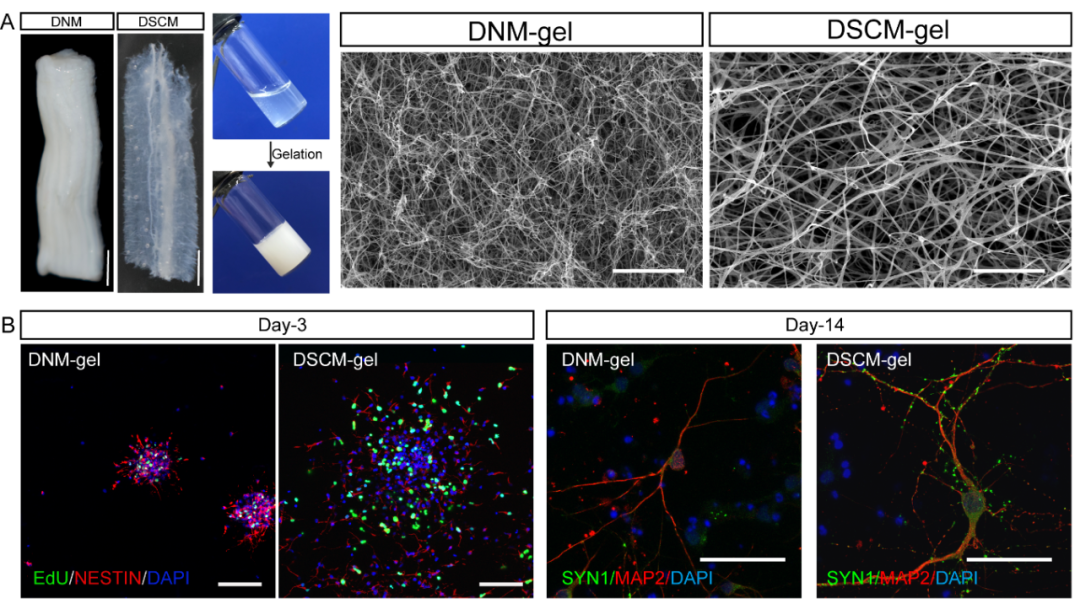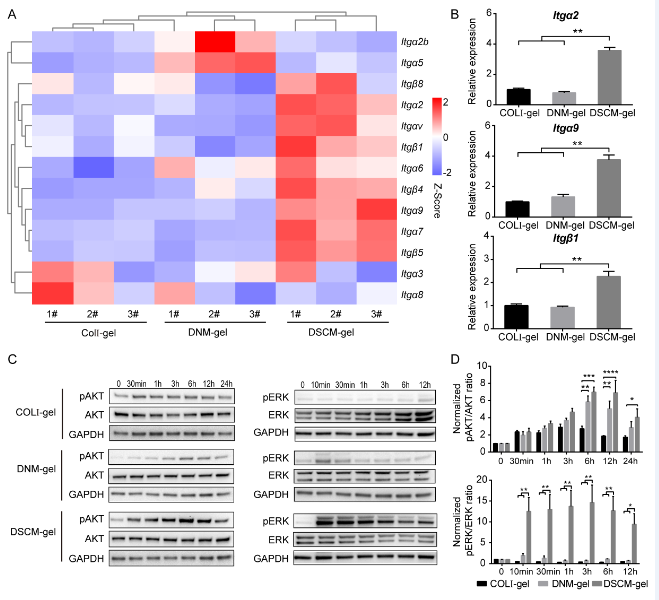
Ideal biomaterials can provide physical support for tissue regeneration in the process of spinal cord injury repair, and play an important role in improving the microenvironment and activating intrinsic neuron regeneration capabilities as a carrier for cell transplantation or growth factors. The tissue-derived acellular matrix hydrogel is a natural biological material and has become a research hotspot in soft tissue repair or tissue replacement therapy in recent years. At present, acellular matrix hydrogels derived from a variety of animals have been widely used in tissue engineering and regenerative medicine research and even clinical practice. More and more research reports indicate that the active ingredients in tissue-derived acellular matrix hydrogel retain high tissue specificity, which may play a vital role in tissue repair. Previous studies have found that acellular peripheral nerve matrix hydrogel can promote the myelination of new axons and inhibit synapse formation, reflecting the tissue specificity of the acellular matrix derived from peripheral nerves (Zou et al. Adv. Funct. Mater. , 2018). However, the acellular spinal cord matrix hydrogel, which is also from the nervous system, has not yet been explored in depth. How its compound components regulate the fate of neural stem cells and its effect on the repair of spinal cord injury still need to be further explored.

Figure 1. Preparation of acellular matrix hydrogel, SEM characterization and three-dimensional culture of neural stem cells. The author used materials science, transcriptomics, matrix histone analysis and other methods to analyze decellularized spinal cord matrix hydrogel (DSCM-gel) and decellularized nerve matrix hydrogel (decellularized nerve matrix hydrogel, DNM-gel) was analyzed and compared. It was found that the two acellular matrix hydrogels retained the nanofiber structure similar to that of the extracellular matrix, but the porosity and fiber diameter of the DSCM-gel were slightly higher than that of the DNM-gel. The neural stem/progenitor cell (NSPC) was embedded in acellular matrix hydrogel for three-dimensional culture, and it was found that DSCM-gel is more conducive to the survival, proliferation and migration of NSPC, and can promote the nerve of NSPC Yuan to differentiation (Figure 1). Combined with RNA-Seq expression profile sequencing technology and bioinformatics analysis, it is found that the DSCM-gel three-dimensional culture mode can significantly promote the differentiation of NSPC neurons and accelerate the maturation of neurons. Transcriptome analysis further showed that DSCM-gel regulates the behavior of NSPCs by regulating the expression profiles of integrin genes (itgα2, itgα9 and itgβ9) and AKT/ERK-related signaling pathways (Figure 2). Proteomics analysis shows that DSCM tissue-specific extracellular matrix proteins, such as laminin (LAM), tenascin family (TNC) and some soluble growth factors (FGF2) may be involved in these regulation (cover image). In addition, in vivo evaluations confirmed that DSCM-gel provides a suitable microenvironment for the recruitment of endogenous NSPC and axonal regeneration after complete spinal cord injury in rats.

Figure 2. DSCM-gel regulates the expression of integrin genes and AKT/ERK-related signaling pathways regulate the behavior of NSPC. Correlating the three-dimensional microenvironment provided by the acellular matrix with its specific cellular regulation is crucial for the design and manufacture of multifunctional biomaterials. This study has further deepened the understanding of the composition, tissue specificity and biological functions of the tissue-derived acellular matrix, clarified its role in affecting the fate of neural stem cells, and also verified that the acellular spinal cord matrix hydrogel is used as a transformed biological material. Great potential in the repair of spinal cord injury. The first author of the paper is Xu Yiwei, a doctoral student in the School of Chemistry, Sun Yat-sen University, and the co-corresponding authors are Professor Quan Daping and Associate Professor Bai Ying from the School of Materials Science and Engineering, Sun Yat-sen University, and researcher Zhang Xiao from the Guangzhou Institute of Health and Medicine, Chinese Academy of Sciences.
Professor Quan Daping: PhD, double-appointed professor and doctoral supervisor in the School of Materials Science and Engineering and the School of Chemistry, Sun Yat-sen University. His main subject areas are biomedical polymer materials and tissue engineering. He is currently the director of Guangdong Functional Biomaterials Engineering Technology Research Center, a member of the Board of Directors of the Chinese Society of Biomaterials Neuroremediation Materials Branch, an executive director of the Guangdong Society of Human Tissue Engineering, and a director and chief scientist of the Guangzhou Rehabilitation Medical Equipment Industry-University-Research Collaborative Innovation Alliance. Research interests include the design and synthesis of absorbable functional polyester, neural tissue engineering (central nerve, peripheral nerve), basic and application research of acellular matrix biomaterials. Has undertaken 2 national key R&D projects, presided over 7 National Natural Science Foundations (including 1 Guangdong-NSFC joint fund key project), presided over 1 Guangdong Province key field research and development plan, provincial and municipal scientific and technological research and related cooperation projects10 Multiple. Nearly 110 papers have been published in research on implantable biomedical materials, tissue engineering scaffolds and drug slow-release carrier materials.
Professor Quan Daping research group at Sun Yat-sen University is now looking for post-doctoral and full-time researchers. Young doctors with professional background or relevant experience in polymer chemistry and physics, tissue engineering materials, cell/molecular biology, animal experiments, etc. are welcome to join. Among them, the age of specially-appointed researcher and specially-appointed associate researcher is not more than 38 years old when they are first hired, and the salary package is 200 to 360,000 yuan. Positions are determined according to personal circumstances, basic salary of 140,000 to 300,000 + unit five insurance and one housing fund + performance bonus 0 to 100,000, the employment period is three years, after the contract expires, you can renew or recommend the position of associate professor and above, or recommend to China Work in other colleges and universities. Post-doctoral researcher positions, in principle, recruit the outstanding doctors at home and abroad who are under the age of 35 and obtain a doctorate degree in less than two years, with a high academic level and strong scientific research capabilities. (A) Postdoctoral fellow in school: annual salary of 200,000 yuan + unit s five social insurances and one housing fund + performance bonus of 0 to 100,000, providing revolving housing, children s enrollment, etc.; (b) Boxin Project post-doctorate: annual salary of 300,000 yuan + units five insurances One fund + performance bonus of 0-100 thousand, housing, children s enrollment, etc.; (c) Guangdong Province Pearl River Talent Program (Postdoctoral Funding Project) : annual salary of 300,000 + unit five insurance and one fund + performance bonus of 0 to 100,000, Provide housing, school for children, etc.; workers who continue to work in Guangdong after leaving the station can receive 400,000 relocation allowance. Post-doctoral candidates will be recommended to compete for higher-level positions (teachers and full-time scientific research positions) or foreign job opportunities based on personal intentions. Contact: E-mail (cesqdp@mail.sysu.edu.cn, the subject of the mail indicates: application position + graduate school + my name) or telephone (020-84114030).
Associate Professor Bai Ying: Ph.D., introduced by Sun Yat-Sen University’s Hundred Talents Program , graduate tutor of the School of Materials Science and Engineering, core member of the Nanomedicine Engineering Innovation Team of the Guangdong Province introduced innovation and entrepreneurship team. The main research interests and scientific research directions are biopolymer materials, biomedical materials and tissue engineering, and biological 3D printing technology. Research projects include five national key R&D plans for the 13th Five-Year Plan, presided over the National Natural Science Foundation of China Youth Project, and Guangzhou Science and Technology Plan projects. He has published more than 20 papers in high-level journals such as Advanced Functional Materials, Science Advances, ACS Applied Materials and Interfaces, etc. as a correspondence or as the first author.
Researcher Zhang Xiao: Ph.D., Guangzhou Institute of Biomedicine and Health, Chinese Academy of Sciences, winner of the Chinese Academy of Sciences Hundred Talents Program, double-employed Biological Island Laboratory, won the 2019 Zhu Liangyi Youth Innovation Award , Director of China Instrument and Analytical Instrument Branch, Deputy Secretary-General . He has a background in macromolecule and cell therapy translational medicine, and he has unique insights into the application of mechanical design, optics and automation control in life sciences. After returning to China, he led the completion of the research and development of the world’s first fully automated stem cell induction culture equipment, established equipment technology for automated stem cell cultivation, online microscopic observation, pipetting and liquid exchange, and clone picking, and realized the use of machine learning and artificial intelligence algorithms for the first time Automated induction of reprogramming fate for judged cells. Disease research focuses on the functional verification of TILRR protein and the cultivation of kidney-like organs in vitro. The independent research and development direction of the instrument focuses on the research and development of cross-diffraction limit three-dimensional light sheet microscopy equipment, fully automatic cell induction culture equipment, 3D printing and other directions. He has published many papers. In the past five years, he has published 4 articles in a district (IF>101) as corresponding authors; 48 patents have been applied for, including 1 US patent, 1 PCT, and more than 30 authorized invention patents.
Paper information:
Yiwei Xu, Jing Zhou, Cuicui Liu, Sheng Zhang, Fenglin Gao, Wenjing Guo, Xiumin Sun, Chi Zhang, Heying Li, Zilong Rao, Shuai Qiu, Qingtang Zhu, Xiaolin Liu, Xiaodong Guo, Zengwu Shao, Ying Bai*, Xiao Zhang , Daping Quan . Understanding the Role of Tissue-Specific Decellularized Spinal Cord Matrix Hydrogel for Neural Stem/Progenitor Cell Microenvironment Reconstruction and Spinal Cord Injury. Biomaterials 2020, 120596.
Information source: Biomaterials
This information is from the Internet for academic exchanges. If there is any infringement, please contact us and delete it immediately






